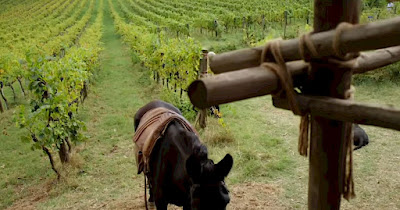The TV series "I Medici" premiered on Italian television in 2016. I haven't had a chance to watch the whole series but I was greatly entertained to see in some clips how they re-created Renaissance scenes using digital composites. I'll show one or two here and add some more in due course.
Here's a scene which represents one of the gates of Florence during Renaissance times.
A scene of Florence from the TV series on the Medici family
Observant readers (all of my readers are observant) will notice, first, that the Duomo sports the decorative facade that was added in the 19 C. The original facade was the raw brickwork that we still see on some other Florentine churches. So that was a blooper that they hoped no one would see - or perhaps they didn't know? It would have been easy to photoshop the facade for the digital background of this scene. The dome is depicted as completed, but that might be correct, depending on the period represented. Elsewhere in the series they make a big deal of the uncompleted dome.
Now let's look at the gate where live action is taking place in the film. That's the Etruscan gate at Volterra with the fake Florence in the background.
The Etruscan gate at Volterra in Tuscany
Now what about the Ponte Vecchio? Here it is in the series with its four arches - whoops, how many?
The digital Ponte Vecchio in Florence
The Ponte Vecchio has three arches (see below) and, furthermore, the Vasari Corridor, which is depicted on the bridge in the digitalised background of the TV series, was not built until 1565 (by the Grand Duke Cosimo I de’ Medici).
The Ponte Vecchio as it looks today in Florence
Now here's a Tuscan countryside backdrop from the scene leading up to the death of Giovanni di Bicci de’ Medici (who died during February when the grape vines have no leaves and it's way too cold to be munching grapes outside). Oh, and he was not poisoned or murdered in any other way.
Vineyards in Renaissance Tuscany according to I Medici
Vineyards like this didn't exist much before 1950. These are post-war grape vines. We call them "Fiat vineyards" because the rows of vines are planted just wide enough apart for a Fiat caterpillar tractor to plough between them. Prior to that, Tuscan farms used the method known as "cultura promiscua" where vegetables, wheat, olive trees, vines etc were planted in close proximity. In Renaissance times, grape vines were grown more or less wild through trees. Children used to climb up for the bunches of grapes which they threw down to the adults below. Furthermore, most of the Tuscan countryside was planted with wheat, with far fewer olive trees on cultivatable ground and even fewer grape vines. 'F' for that one, I'm afraid.
Next time you want to film a TV series on location in Tuscany, maybe hire me as an advisor!
More about Volterra.
More about the history of the Medici family in Tuscany.
More about the history of the Medici.
More about films shot in Tuscany.
|
Author: Anna Maria Baldini







